Sometimes there’s a great joy to not knowing what’s going on. This is what I’ve been feeling the past two weeks or so as I’ve read Seth Dickinson’s challenging, dazzling Edge of Eternities web fiction.
On the level of the synopsis, the story is simple enough. Roguish pilot and loyal first mate are tasked with delivering strange artifact to mysterious employer, along the way dodging hostile factions and said artifact’s time-warping abilities. But of course, it doesn’t read that way. For reasons I’ll discuss in a moment, the stories are esoteric, disorienting, puzzling, and deeply, deeply powerful—precisely in being difficult. In this article, I’d like to unpack why.
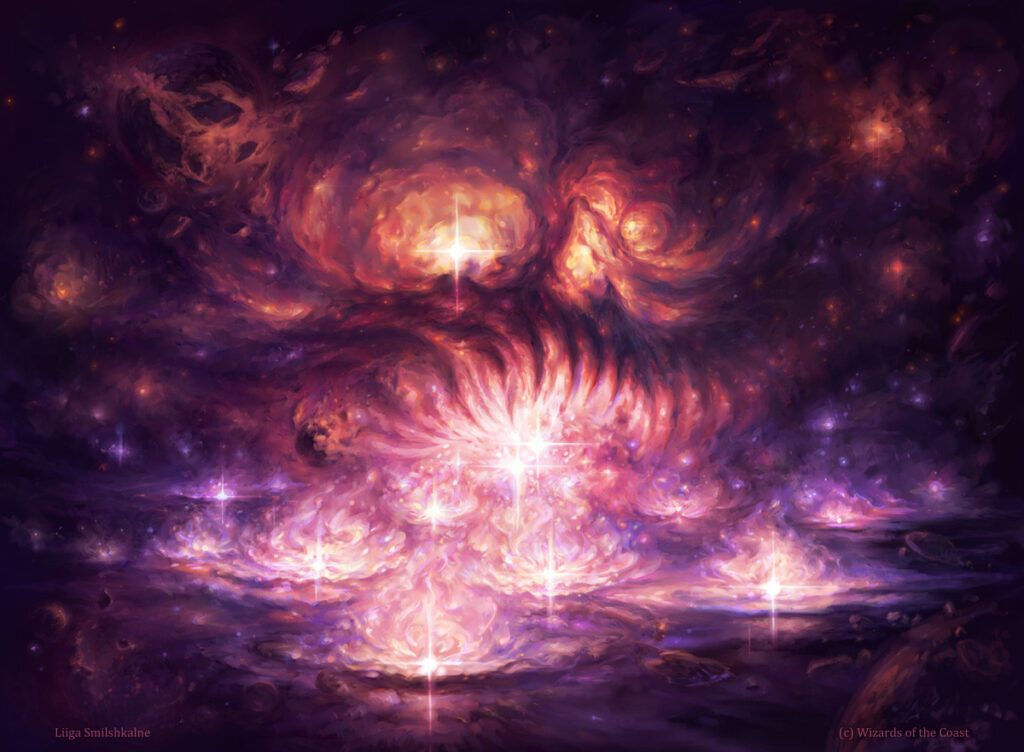
Swamp by Liiga Smilshkalne
We don’t tend to associate literary difficulty with Magic story, or with much fantasy/science fiction in general. Typically (and I say this as a great lover of much Magic story) the game’s web fiction is more about the spectacle than the cerebral.
To a certain extent, there are production-side reasons why Magic’s story often trades in the cinematic. Web fiction is usually enclosed both by tight word limits (presumably bound to pay for writers) and by the plots charted by Wizards of the Coast’s story team. This means that each story needs to hit beats quickly and efficiently. Maximum content in as short a span as possible.
But this is also a stylistic issue. In our current cultural landscape, the dominant forms of media, especially sci-fi/fantasy media are not written but rather visual (films, television, video games); this means that writers often take cues from these media when developing their prose. For this reason, we more often see “cinematic” stories, which is to say narrated as though a story is a film playing in the writer’s head: highly visual, focused on describing exactly what a writer imagines, and told by an impassive narrator. Think, for example, of Brandon Sanderson’s Stormlight Archive novels, in which action scenes are narrated with the kinetic action of a video game.
The result of these two influences, the stylistic and the economic, means that Magic story tends to be at best entertaining and at worst a skimmable record of the game’s current meta-narrative. It only rarely activates the power of poetic language to be odd, abstract, and enlivening–as in K. Arsenault Rivera’s March of the Machine story and Alison Lührs’ Outlaws of Thunder Junction epilogue.
Dickinson’s Edge of Eternities fiction turns the weirdness knob to the max. It’s difficult, a little abstruse, and thoroughly resistant to the skim—that’s a wonderful thing.
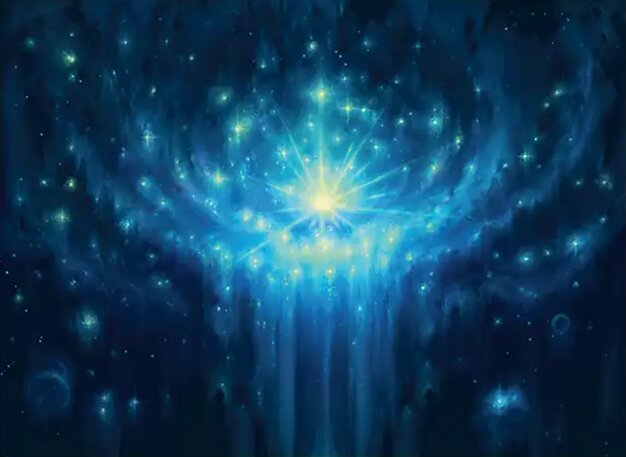
Island by Liiga Smilshkalne
Alien Words, Alien World
One of the most obvious forms of difficulty in Dickinson’s EoE story resides in the minutia of language: jargon. The stories abound with dense sci-fi lingo that blends reality with fiction– subedars and ESM packages, incaglas and nuncio lasers, kamu-shikus and singularity beads.
The easy wave-away justification for this jargon would be to say that it’s “realistic.” Space pilots, you might say (as I’ve seen a few online commenters saying in defense of the story), would be using such specialized language. But there’s something more elegant going on.
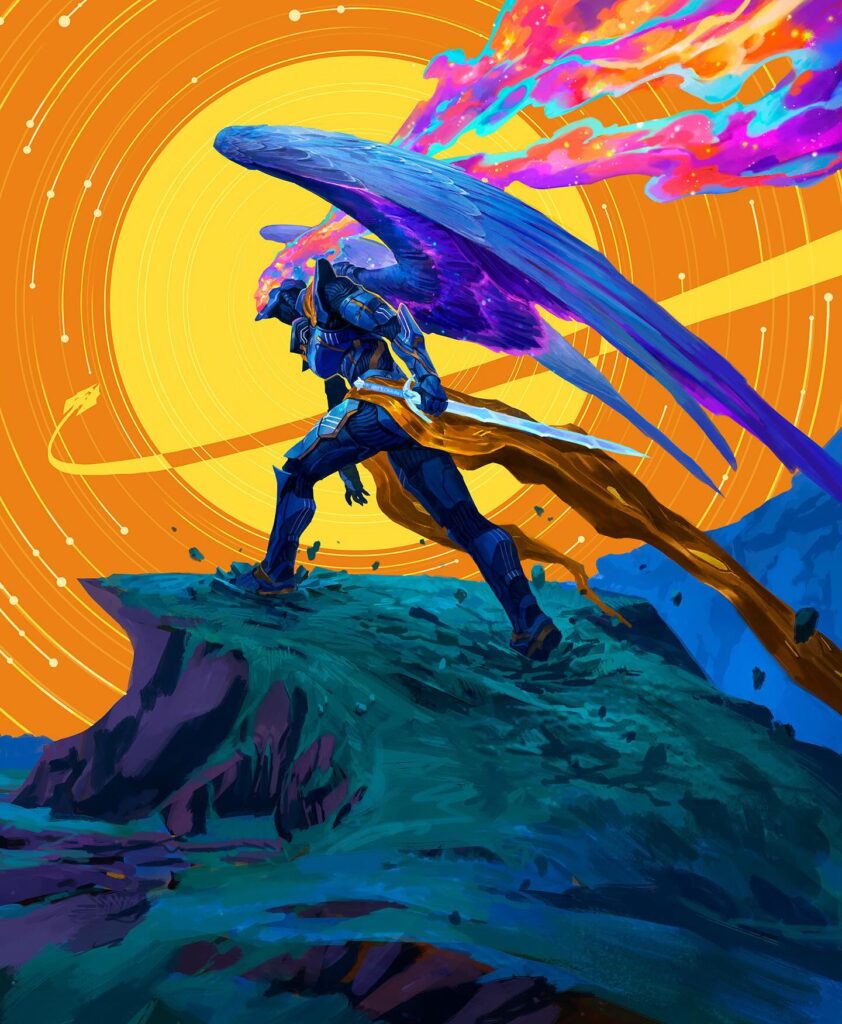
Astelli Reclaimer by Benjamin Ee
All language has a poetic function, which is to say that it does something to us, the reader. In this case, the effect of Dickinson’s jargon is to defamiliarize us, at the level of the sentence, from the world on the other side of the words. The lingo’s half-legible opacity interrupts our attempt to easily immerse ourselves in the world of the Edge, to approach it as though it’s just the same as our world. Instead, we’re pushed away, made to feel that the world is radically different from our own.
In this sense, jargon might make the semantic content of the sentences harder to parse, but it helps open up the world to which it refers. The people of the Edge’s basic vocabulary, the metaphors they live by, the idioms through which they make sense of the universe–they’re only half-comprehensible to our earthly minds. They’re dimly visible but separated from us by a wall, like the Chaos Wall separating the Edge from the multiverse. And precisely because it remains mysterious, the Edge pulses with vitality, alien and alive.
This is to say nothing of Dickinson’s command of real-world language, which swirls into astonishing turns-of-phrase:
“Golden chandeliers like anemones of glass fiber gone dim.”
“It is beautiful. It is a loop. It has no inside or outside. Its mantle is rich with topology—fourfold sphere eversions, triply symmetric immersions like knots of ears, crushed spheres. It flushes pale violet, ultraviolet. It speckles the sight. The atmosphere around it twists warpwise, rushing up and out, a cyclone in wrong dimensions.”
“Salvos of missiles chew through counterfire and jamming to kill. Fighters arc like the tips of sabers, delivering their payloads and racing away again, dying or escaping as cold math and hot fluid test each other to the end…Radars scream at the dark, begging for an answer: Where is death? How fast? How soon?”
These kinds of phrases, which litter the Edge of Eternities stories, are beautiful and visually stimulating, but they’re not cinematically transparent in the way that much run-of-the-mill fantasy writing is. As an example, let’s read through the first line I quote above.
“Golden chandeliers…” Okay, makes enough sense.
“Golden chandeliers like anemones…” This is something more complex and more vivid, this suggestion of chandelier-as-anemone. Sea anemone? Anemone flower? Either way, we’re now imagining a chandelier in terms of coronal, tendrilous organic matter.
But wait: “Golden chandeliers like anemones of glass fiber…” Now what could that mean? A chandelier that’s also an anemone that’s also made of glass fiber–not just glass, which would make enough sense, but rather glass fiber, perhaps like the fibrous root of a plant or perhaps like the fibers of the Summist’s artificial equipment?
“Golden chandeliers like anemones of glass fiber gone dim.” Whoa. The sentence now reveals itself as a fragment; the word “gone” is not a verb, but the shadowy afterimage of one. We think at first we’re going to imagine a thing in motion, but instead, we have a frozen image and a weird sense of retained momentum, all the linguistic potential energy of the initial analogies clotting together instead of diffusing. Power seems to course through this language.
This is one sentence with nine words. But in those nine words, Dickinson has given us a sense of what the reality of this world feels like, at its very core—at once oblique and pulsing with energy. This is something that literalistic cinematic description can’t do. The EoE story asks for the reader’s imagination to whirl and pirouette along with it, to construct images that transform on the fly and that pulse with a strange otherworldly force.
Questions Unanswered
But Dickinson’s writing isn’t just mechanically challenging. It’s also esoteric and abstruse in the ideas it charts, the scale of meaning it sets, the stakes for which it grasps.
It becomes obvious from the first lines of EoE’s first episode that we aren’t dealing with a run-of-the-mill pseudo-cinematic adventure.
REVISION 0
I lie in the clay until the sun explodes and shatters me.
End of failed timeline.
>Start over.
REVISION 1
I create you.
Who is ‘you’?
You are the person who imagines I am me.
The very medium of the story here is thrown into question. Although the story’s voice eventually settles into familiar present-tense free-indirect narration, our entry point into the story is through a voice that seems at once omniscient and fragile, computerized and human.
Like the jargon we discussed above, the choose-your-own-adventure format prevents us from seamlessly slipping into the world of the Edge. Instead, we have to enter it as self-reflexive, partially unwilling participants; our initiation to this world entails an act of co-creation (“I create you…the person who imagines I am me”), but is also dependent on an eerie alien presence (“>Start over.”)
Indeed, the story further problematizes the choose-your-own-adventure as we go along. Even though it gives the reader the putative choice to direct the flow of events, it becomes apparent that choice is a feint. What appear to be branching paths are actually little microtimelines that the narrator, eventually revealed to be the strange artifact at the story’s heart, closes down once they interfere with its goals. “This outcome,” it repeats in six paths in Episode 9, “cannot stand.” It makes things more explicit in another: “Go back and make a better choice.”
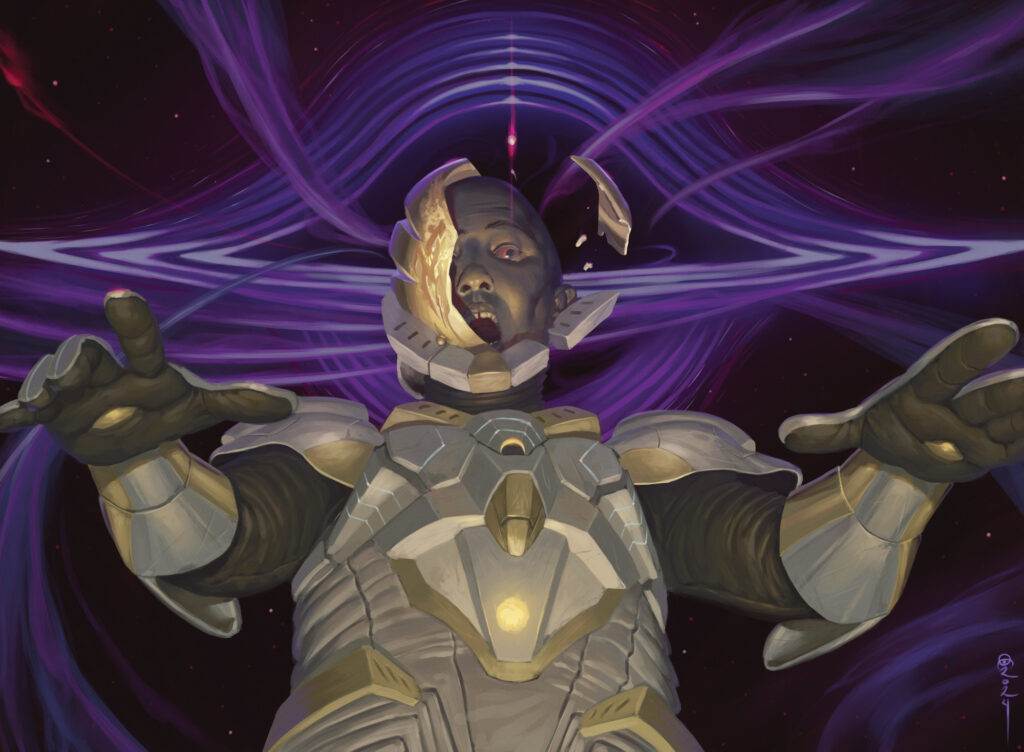
Tragic Trajectory by Ovidio Cartagena
This is, to say the least, not a transparent reading experience, particularly since it takes a few episodes for us to realize what’s going on. But the story’s framing device initiates us into another of the productive difficulties at the story’s heart: Dickinson gives voice to enormous, opaque, metaphysically challenging issues.
The Edge is part space opera playground, part theoretical physics existential nightmare. Its inhabitants grapple with the very nature of time, space, life, the universe, and everything, and Dickinson’s language metabolizes these challenges. The reader is haunted, like Sami and Tannuk at Sigma’s Reach, by the sense of a malign force beyond their control. We might feel something familiar in Sami’s reference to an in-universe horror writer who represents the universe “as a malignant puppet show operated by unknowable beings who mock human notions of causality.”
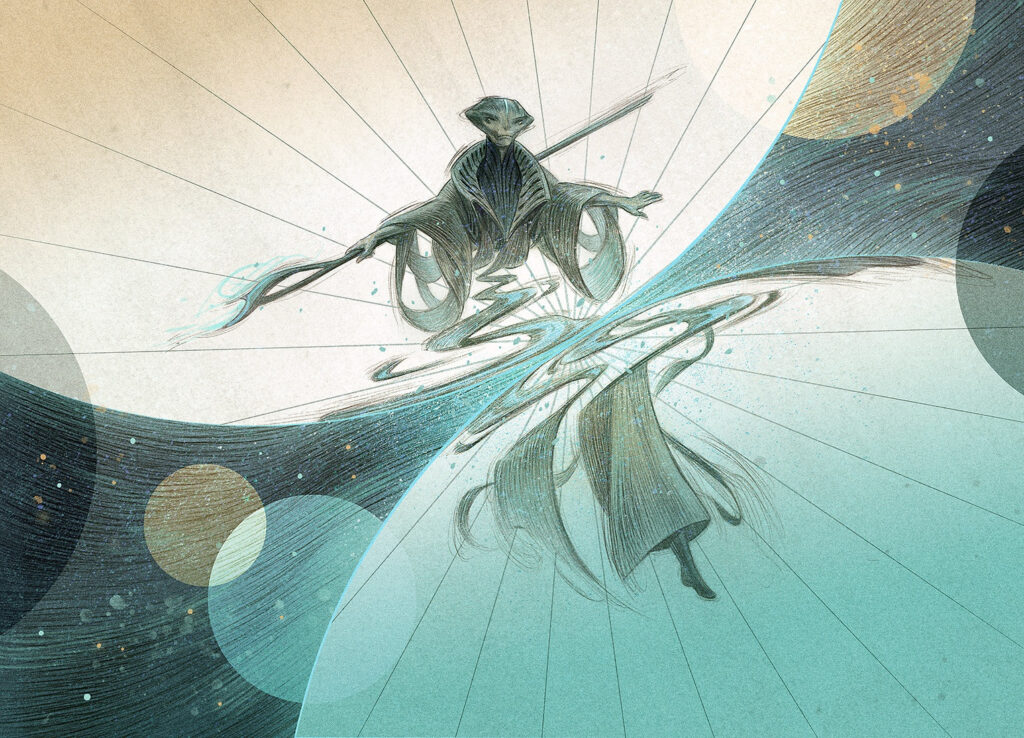
Weftwalking by Rovina Cai
And there are other metaphysical voices that seep into the prose. Such becomes evident when the story pivots to the conflict between the Summists and the Monoists, whose philosophies are both built out of recognizing the reality of universal heat death and whose theology is profoundly mystical. The Monoists worship gravitational force, inner truth, the unknowable void of the self, the possibility of another world; the Summists revere cosmic light, the mathematical sublime, scales of time and meaning beyond mortal comprehension but bounded by finite existence.
Dickinson doesn’t shy away from these heady beliefs. Indeed, his prose actually absorbs them into itself, working in the register of cosmic mysticism to unfold their messianism-by-way-of-astrophysics.
For the Monoists:
“Gravity is the gift of purpose. A free path. Effortlessly, we speed to our fate. And when we are close enough to fate, time and space change places. Going down becomes the same as passing time. The absence of effort, the geodesic of destiny. Obey your nature. Acceptance, not resignation. Inevitability, not inaction. Do what comes to you. The fact that it came to you makes it right. Down is the same as tomorrow. Nothing tests our faith.”
Gravkill means gravity killer, but there’s a simpler word for the place you’re drawn to die: your grave. Call the Thinner grave-killer, for he kills foes before their time. All the garden rattles like a drum, beat by the gravid power of his grave.
“INEVITA! Begin in me thy ending! Chart my winds so I may blow like a shroud. Shrive me! Make me fringent to the narrowing course of thy heart. Pare from me fate’s gore. Let me begin with thee. Even and event. O INEVITA, draw me down! Crush my hands and flatten my feet so I may pass only on the flat way of thy preparation! How perfect, how final you are! Brush me with the omens of thy coming! Eat me with the teeth of thy throat! INEVITA my fate and love! Oh, INEVITA, I see thy hip, I see thy shoulder, I see thy empty face!”
For the Summists:
According to the Grand Cosmocordance of the Summist faith and the physics of sunlit reality, there is no time travel. The past cannot be altered. In fact, it does not exist. There are no parallel universes, timelines, frozen past, or beckoning future. There is only the now, the present, the space between the Walls, between infinity and nothing. And thus, no fixed future to prophesize.
Pendulum, encoding faith. Fashion from gleanings a triple-jointed pendulum. Dangle it from thy armor. Every second, glean its velocity vector, use it to select a scripture from the Faith Space. Broadcast the selected scripture to the nearest secure router of the faithful to be repeated in prayer every day for the next thousand years. Travel calmly to the nearest coronal and say unto them, “Coronal, the avalanche of things moved by liturgy protects me. Now save me from INEVITA.” (Recorded successes: none)
“Praise the dawn light, praise for the morning
As it rises, so do we rise
Praise the dawn light, spark of creation
As it rises, so we all rise
Praise the dawn that drives time and motion
As it moves us, so we will move.”
I would quote more, but if I went further, I’d end up copy-pasting the entire text of every story. Still, these samples should be enough to see, first of all, that this writing is not for the faint of heart—these aren’t commonsensical summaries of articles of faith—and, second of all, that Dickinson’s language enlivens the story’s cosmological drama.
This is not “Good is cool and evil is lame” philosophy. This is human fallibility grappling with enormous questions, the kind of questions that necessarily resist literalistic language and push toward the counterintuitive enormities at the heart of our universe. Fittingly, Dickinson’s language is eclectic in the styles it adapts: incorporated into these excerpts are the idioms of quantum physics, existentialist musing, mystical poetry, liturgical exultation, and more.
And just as these languages blur into each other, they also blur into the story’s prose. Summism and Monoism aren’t framed with any ethnographic remove, where a safe commonsensical narrator says “The Monoists believe X, and the Summists believe Y.” Rather, the language takes on the internal opacity and mystical reverie of these belief systems. The story’s drama unfurls partly through philosophical language; indeed, as in some of those quotes above, Dickinson slips, almost unnoticeably, from one to the other, cosmo-mystical thought laminating onto the material action of the story.
Doing so doesn’t offer a clear summary, but it does offer something better: a glimpse into the existential weight of the Monoist and Summist philosophies. The world feels charged with real mystery, the kind that high-level science and religious thought alike open up to us.

Beyond the Quiet by Serena Malyon
The external benefit of this weight is that it makes Dickinson’s characters feel profoundly real in their struggles. In so doing, Dickinson (to my mind) pushes against a great many works of sci-fi and fantasy whose plots are concerned with unimaginably profound problems, but character arcs are rather pedestrian. The world might be ending in apocalyptic destruction, but all the protagonist really needs to do is forgive themselves or accept that it’s okay to ask for help or learn that you didn’t deserve to get hurt.
The characters of Edge of Eternities are not like that. They are always thinking about big questions, because in a world like theirs, there’s nothing more fitting to think about. Are sentient beings destined for self-destruction? Is there any use to living in a fallen world? Can power be compassionate? How do you live with having caused untold suffering? What is the value of a single life?
Indeed, it’s Sami, the character with the most deceptively simple motivation (Find my cat), whose metaphysical angst is most lucidly powerful:
Maybe Mirri’s a lesser thing than a person. The way you or I would be lesser than a—a Drix, or a god, if there are gods. So? So? Would that change anything? Shouldn’t we treat lesser things better than we treat ourselves? Wouldn’t you hope, if there were gods, that they would chase you across the stars just to make sure you were all right? Even if Mirri’s less than me, somehow, I have to treat Mirri the way I would want to be treated by a god.”
Here, in what seems to be the most minute problem in an enormous universe, Dickinson’s language evokes the drama of existence itself.
Let me, then, extend you an invitation. Give the Edge of Eternities story a read, if you haven’t read it yet. Read it again if you have, and go slower this time. Let yourself move through the language, in all its difficulty—and notice the world it opens up for you.
Ryan Carroll (he/him) is a writer and Ph.D. candidate in English and Comparative Literature. On Substack as Dominarian Plowshare, he writes about Magic’s art, story, and experience. Outside of Magic, he writes on topics including 19th-century literature, information theory, television politics, and cliche.

